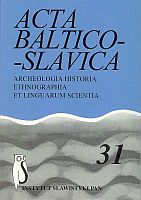Toponimy na -ęta / -enięta na Mazowszu, Podlasiu i Wileńszczyźnie
Place names on -ęta/-enięta in Mazovia, Podlachia and Vilna areas
Author(s): Leszek BednarczukSubject(s): Language and Literature Studies
Published by: Instytut Slawistyki Polskiej Akademii Nauk
Keywords: toponyms; derivation; language contacts
Summary/Abstract: The patronymical toponyms with the –ęta- ending were widespread in Mazovia and Podlassia from 15th to 17th century. In the eastern parts of the Lublin Province under the influence of Westrussian en-ja/ pl. –en-jata formations they took the form of personal patronymics –enia/-enięta. Similar toponyms can be found in the Vilnian Region, particularly in the former oszmiański district and its surroundings. Also, individual examples of such toponyms can be found in the vicinity of Vilnius (Dusienięta), Grodno (Balenięta), Navahradak (Sienniczęta) and Minsk (Pawlinięta). These usually are names of small villages (often settlements). From the 17th Century to this day around 60 such places were accounted for. The starting point were the German-Podlassian –ęta toponyms adjusted to the Belarussian system (of the voŭčenja / voŭčenjata type). They take the Polish phonetic form and Belarussian morphological structure, and their patronymical function developed in Mazovia and Podlassia, to where it had been transferred from the Grand Duchy of Lithuania. They are created from Lithuanian (28x) and Slavic (26x) stems, some of which are of Polish (nasal vowels and other features), the majority, however, can be derived from the Belarussian. Apart from the –enięta -forms in the toponyms of the Grand Duchy of Lithuania we can notice other formations created as a result of Polish-Lithuanian-Belarussian contacts : (1) personal patronymics and patronymic toponyms –ańce, which were developed from the Lithuanian –onys transpositions, (2) –iszki toponyms of Lithuanian origin, created also from Slavic stems, (3) the -–owszczyzna formations, which are the result of the contamination of the Polish affix -(ow)izna by the Russian -(ov)ščina, (4) prefixal names like Bez-kłopoty, Nad-wilia, created in the same manner as the Polish Pod-gaje. These are an evidence of the presence of the Polish language there, transferred from Mazovia and Podlassia. This was first pointed out by professors I. Grek-Pabisowa and I. Maryniakowa.
Journal: Acta Baltico Slavica
- Issue Year: 2007
- Issue No: 31
- Page Range: 33-43
- Page Count: 11
- Language: Polish

